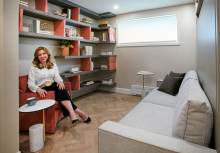Architects & Designers Speak Out: 91% Say Adaptability Is Key

Our homes have become our sea anchors, keeping us steady as the world surges and shifts around us. Once only tasked with providing shelter and a place to eat, sleep, and relax, homes today now must be able to instantly transform into a conference room, a second-grade classroom, a gym, a physical therapy facility, a sewing room, and more.
But without the luxury of being able to pack up and move to a larger home, how is it possible to gain extra functionality? How do you create more space – without having more space?
In late summer 2020, Resource Furniture asked 131 architects and interior designers these questions and more: what doing business during a pandemic looks like, what their clients are now asking for, and how they are responding to the increasing demands on a normal, unsuspecting home.
Unsurprisingly, the word used most often to describe what their clients are looking for right now? Flexibility.
Architect Sara Jazayeri, founder of Studio 360, was faced with just such a situation when she was approached by her clients, a Westchester couple, to renovate their split-level, three-bedroom home. Though they occupied over 2,000-square-feet, both were working from home full-time while sharing the space with one of their adult children. The couple’s life at home had changed dramatically over the past several months, and the new demands on their physical space were taking their toll.
Just like 91% of our survey respondents, what Sara’s clients asked for – and needed most – were flexible spaces that could be used for multiple purposes: for example, a home office, study, and guest room in one. Sara was able to create three flex rooms in this home, allowing what was once a static layout to now adapt on-demand to the needs of the occupants.
A need for a second home office, an overall lack of privacy common in split-level homes, and a plan for aging-in-place were the drivers for this renovation — but achieving all of these goals required a holistic design approach and a complete rethinking of the overall space.
For instance, one of the clients’ most challenging requests was to open up the dark, cramped garage-level study, while still retaining the ability to cordon off the space when extra privacy is needed.
Sara removed the entire doorway wall, allowing the space to be reborn as a bright and airy room that looks, feels, and functions like one twice the size. Specifying Resource Furniture’ Circe Sofa queen wall bed, Sara was able to furnish the space with a much larger sofa than what was originally there, while allowing the room to function as a guest room for two. This level now feels open and welcoming, but when guests need privacy, a motorized shade system quickly provides separation.
And because this room is located on the garage level — which Sara also equipped with an expanded bathroom and a roll-in shower — it is effectively future-proofed, serving as a perfect area for aging-in-place.
One more level down, the basement-level family room was reinvigorated with a custom fireplace and reclining queen sleeper sofa, as well as its own motorized privacy shade for additional guests.
On the uppermost level, a 100-square-foot bedroom no longer in use by the couple’s adult daughter was transformed into a hyper-functional media room/guest room/second home office using two additional transforming furniture systems from Resource. Sara specified the Oslo Sofa queen wall bed, which allows this room to instantly convert from a media room to a guest bedroom with a queen-size bed for their daughter’s occasional visits. Meanwhile, the Spechio fold-down desk/mirror provides a generous work surface, designed for everyday use.
Not only did this renovation open up, connect, and modernize disparate areas, Sara’s clever space planning reconfigured the home to meet the clients’ needs today and into the future. With a new laundry room, a larger bathroom, and two new separate offices, this multi-functional home now boasts three new guest rooms, including a suite for aging-in-place.
Like Sara’s clients, 28% of our survey responses also indicated that a guest room is an important consideration when renovating a home — but how many of them will be lucky enough to have three?
Working on this project during COVID was definitely a challenge, which is no surprise. 75% of our survey respondents said that COVID has changed – and will continue to change – the way they work with clients in some way, with 23% of those saying it will change how they work a great deal.
But not all the changes are negative ones, as Sara discovered. In the absence of in-person meetings and physical showroom experiences, Sara has found 3-D modeling to be an extremely powerful tool for selling complex jobs, like this one.
“Not everyone can understand 2D drawings, especially when the floor plan changes are very complicated and involve taking out or moving walls,” Sara explains. “When I decided to create 3-D renderings of the new spaces, it was a game changer for these clients. They were able to experience exactly how the new layout would work, and signed off immediately.”
3-D renderings were so effective, in fact, that Sara says it will now be a standard part of her firm’s design process.
While COVID continues to present unique challenges for design industry professionals, Sara’s story shows how designers can leverage new technologies — like 3-D renderings and multi-functional furnishings — to keep apace of the shifting industry landscape and, ultimately, better help their clients achieve the added flexibility they need.
